Responsible and Safe Recovery from the Graveyard of the Atlantic
The danger of offshore transit around Cape Hatteras and Diamond Shoals is frequently underestimated. Each year 5 – 20 vessels get stranded on the shallow bars of the Outer Banks as they approach Hatteras Point and Diamond Shoals off of North Carolina’s Barrier Islands. Especially common in the winter months from December through March, this is a traumatic and life threatening experience that should not be taken lightly by any vessel operator, amateur or professional. If you’re a boat owner, insurance company or managing agent, it’s important to find the best solution for recovery of your grounded vessel. In the past, salvage companies or individuals have often acted very hastily in recovering grounded boats from our barrier island beaches. This can lead to personal injuries, environmental damage, pollution, and unnecessary and permanent damage to the shipwrecked vessel and local community. Phillips Boatworks and Crum Works Inc., on Hatteras Island, are a local resource with over 40 years experience in the marine and heavy equipment industry that can respond fast and strategically. Our expertise and local knowledge is not only with the wind, waves and currents of this Barrier Island, but also the engineering and naval architecture of the vessels being recovered. Working with proven contractors on the island, we are savvy at putting together the resources to safely recover most vessels under 70-80 feet in length. From inspection and evaluation of the situation, we can help you find the fastest and most common sense approach to recovering your vessel before the situation becomes worse. We have been able to rescue some vessels with barely any damage whatsoever. Our approach is to ensure that no further damage is done to the vessel in the process of recovery, and that is what sets us apart from most others. But this takes immense resources, so that all the options are available for the best outcome. If your vessel is grounded, beached or shipwrecked on the Outer Banks from Cape Henry to Cape Lookout, you should give us a call 252-489-8193.
The Risk of Cape Hatteras can easily be underestimated
The map of older wrecks easily illustrates how many have underestimated the course around Diamond Shoals. What factors contribute to this?
- Lee Shores on 3 sides – There is a hidden lee shore problem when rounding Cape Hatteras. Not only is it unsafe to be near the shore because of constantly moving sandbars and breaking waves, there is a virtual lee shore obstacle that is actually offshore. The Gulf Stream Current is extremely hazardous and intimidating when combined with strong northerly cold fronts. When gale winds blow against strong 2 – 5 knot currents, it creates a very dangerous sea state where the wind causes the waves to be steeper, cresting and breaking. The thought of sailing out further to sea only to face wave conditions that are nearly impossible is a persuasive reason to stay close to shore. But the shore is just as hazardous. How about turning back toward the Chesapeake? This is also hard on slow and underpowered vessels to sail against gale winds and side shore currents. These factors together create a trap. Once snared it can be at the very least, incredible unpleasant, and at worse, hard to escape.
- Non navigable Inlets – Departing the Chesapeake in calm weather, inexperienced mariners seem to overlook that there is no way to get in from the ocean once the weather turns bad. Inlets like Oregon Inlet, Hatteras Inlet and Ocracoke Inlet are challenging for deep draft vessels in perfect weather. Once wave heights exceed 4 – 6 feet, they become completely impossible for transit by any vessel. In a storm, at night with limited visibility and no local knowledge, chances are very slim that a mariner will make it through the inlet without running aground. Bars are constantly shifting and being dredged, only the most competent local mariners can do this. In a Northerly gale, Ocracoke inlet is the best option during daylight, but one has to get around Diamond Shoals to get there.
- Sandbars as far out as 15 miles – Diamond Shoals is another lee shore hazard in the winter Northerlies. Experienced locals know where to get through the shoals in daylight, but this should never be attempted solely based on electronic chartplotting technology alone. This leaves only one option, if turning back North is undesirable. Sailing east out into the Gulf Stream Current, where it kisses the edge of the Diamond Shoals. In a gale, this will be a rough trip as well. Any problems with the boat or navigation errors will land the vessel on the lee shoals miles from shore in cold water and weather. If your VHF transmits this far is the first question. There is no cell phone reception. Air rescue has to scramble from Elizabeth City, NC or Hatteras USCG Station. This will take a while, so if the water is cold and the boat is sinking, it will be a life threatening situation.
- Distance and time are often underestimated. Winter weather windows are short between cold fronts, especially in January, February and March. Gales get into a cycle this time of year of twice per week if not more. This leaves a very short window for boats to travel out and around the shoals. Departing Cape Henry, it is at minimum 250 miles before the next navigable port as well as 2 sets of Capes and Shoals. For a cruising sailor who averages 6-7 knots in normal seas, this will take almost 2 full days (or 45 hours). Prior to a frontal passage, the winds are frequently strong from the South and Southwest. So this will slow that speed down to an average of 4 knots…. increasing this to 60-70 hours. Once a mariner understands this, it is a fairly reckless endeavor to head outside from Cape Henry in the winter months… The Intracoastal is highly advisable. Chances are in January-March a slower boat will not make it to Moorehead City without encountering gale conditions.
- Unpleasant Escape may be to wait One of the least considered options is actually the most reasonable. If you vessel is not equipped with the capability to drop anchor and ride it out, then you could be considered negligent as a mariner. If your boat is still floating but getting tossed about, its not a pleasant thought, but it is better than sinking or running aground. Drop sufficient anchor and rode to wait it out. You should have a storm anchor and enough scope to securely anchor in 30-50 feet of water (200-400 ft of rode). In a storm, waves could break in water any shallower than this. The offshore waves can reach 30-50 feet and inshore waves will be 15-20 feet in the winter at the worst. This means that any marginally shallow area will present with breaking surf, as far out as 15-20 miles from shore. In the middle of the Ocean a Sea Anchor is a smart tool to have on board, but near shore and in shoal waters, sometimes staying put in a safe spot (maybe rough and uncomfortable) is better than the other options.
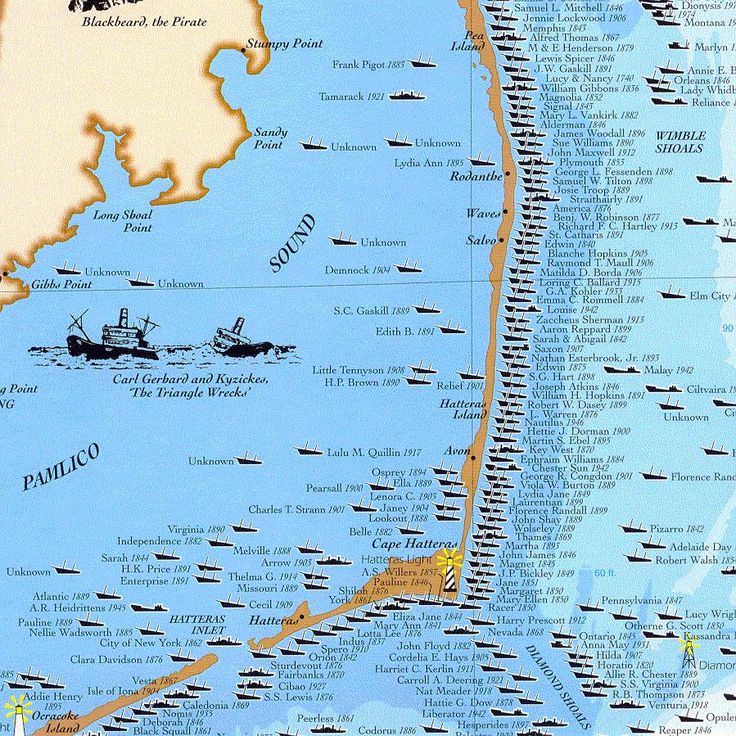
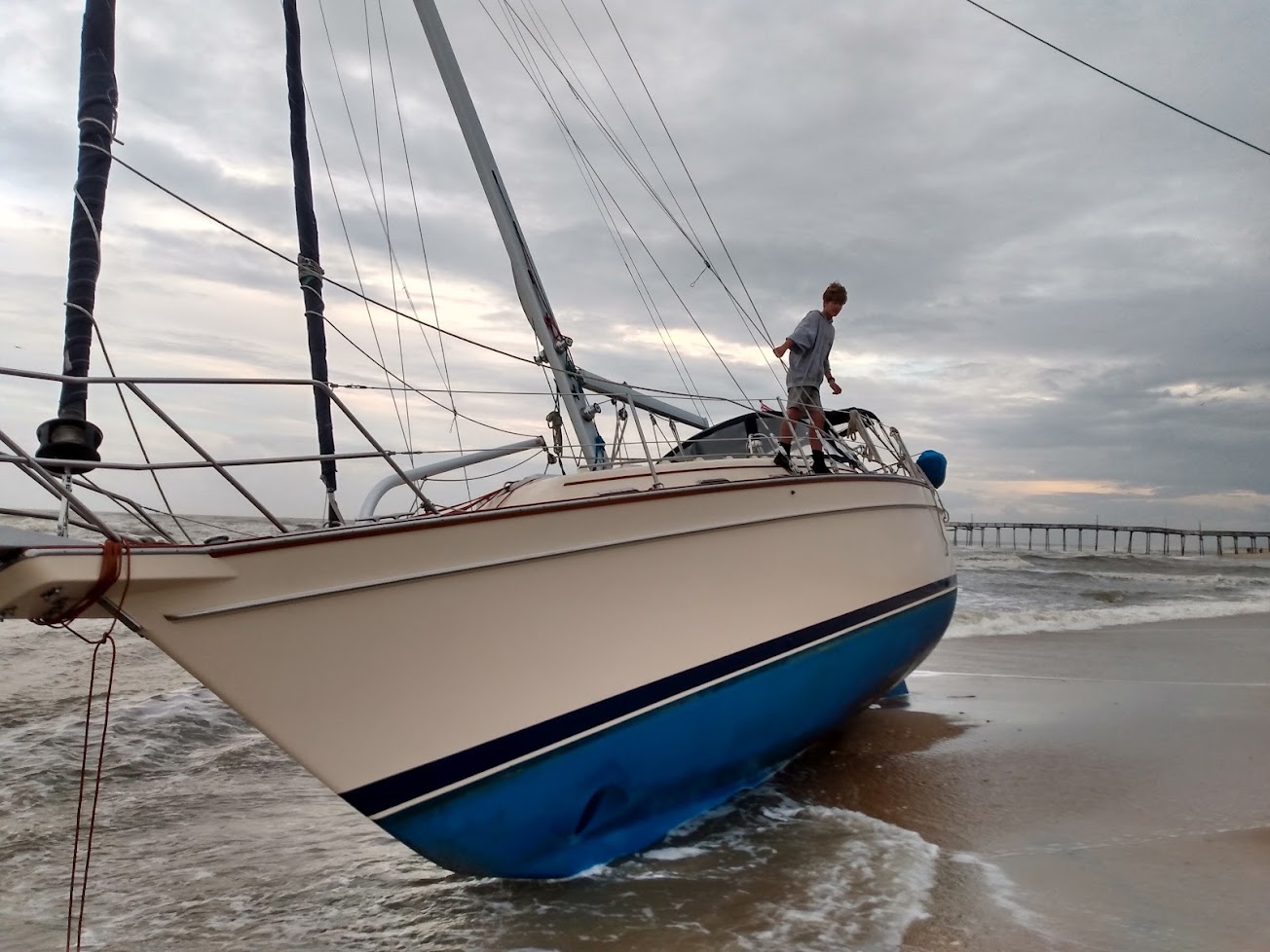
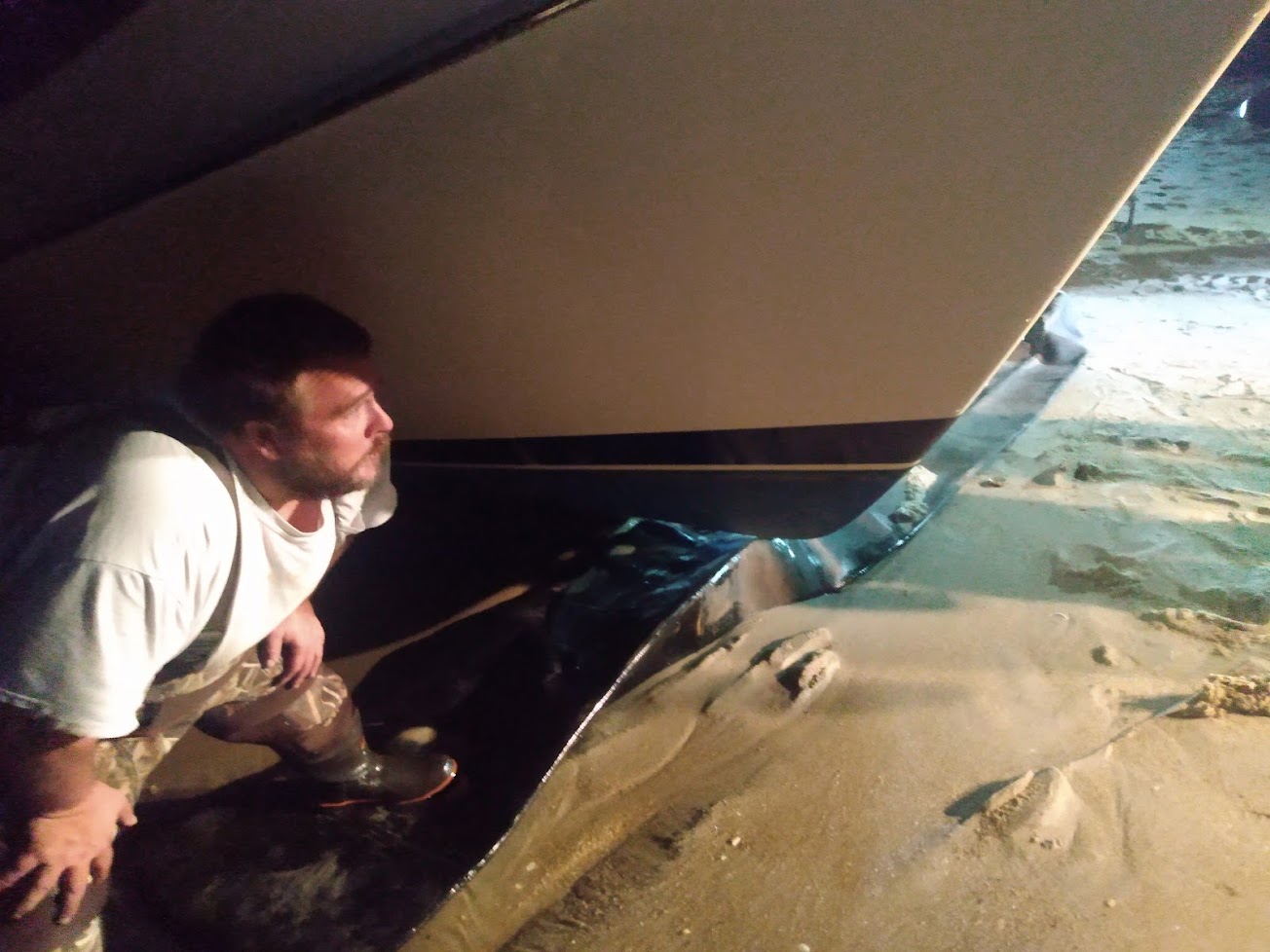
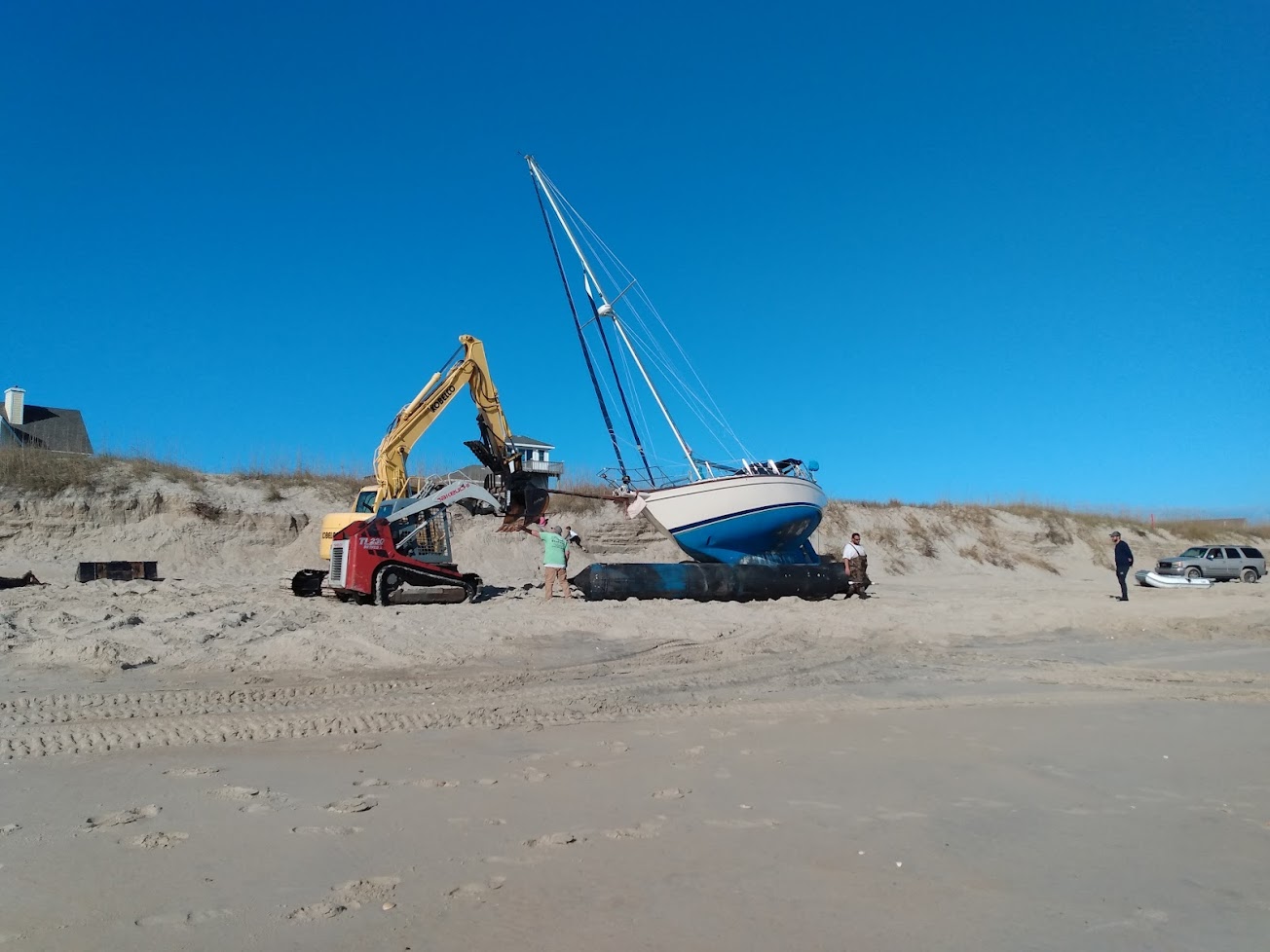
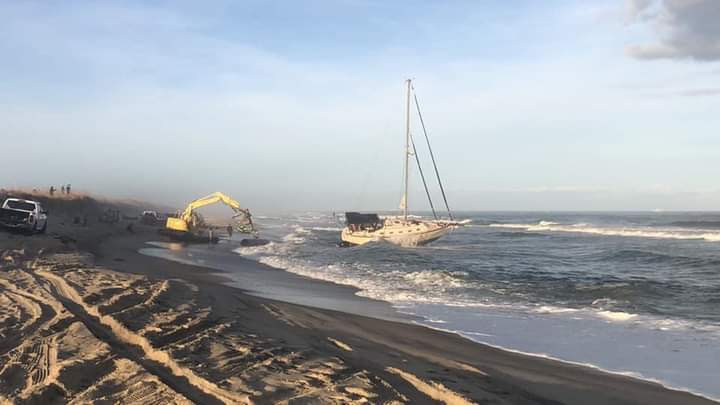
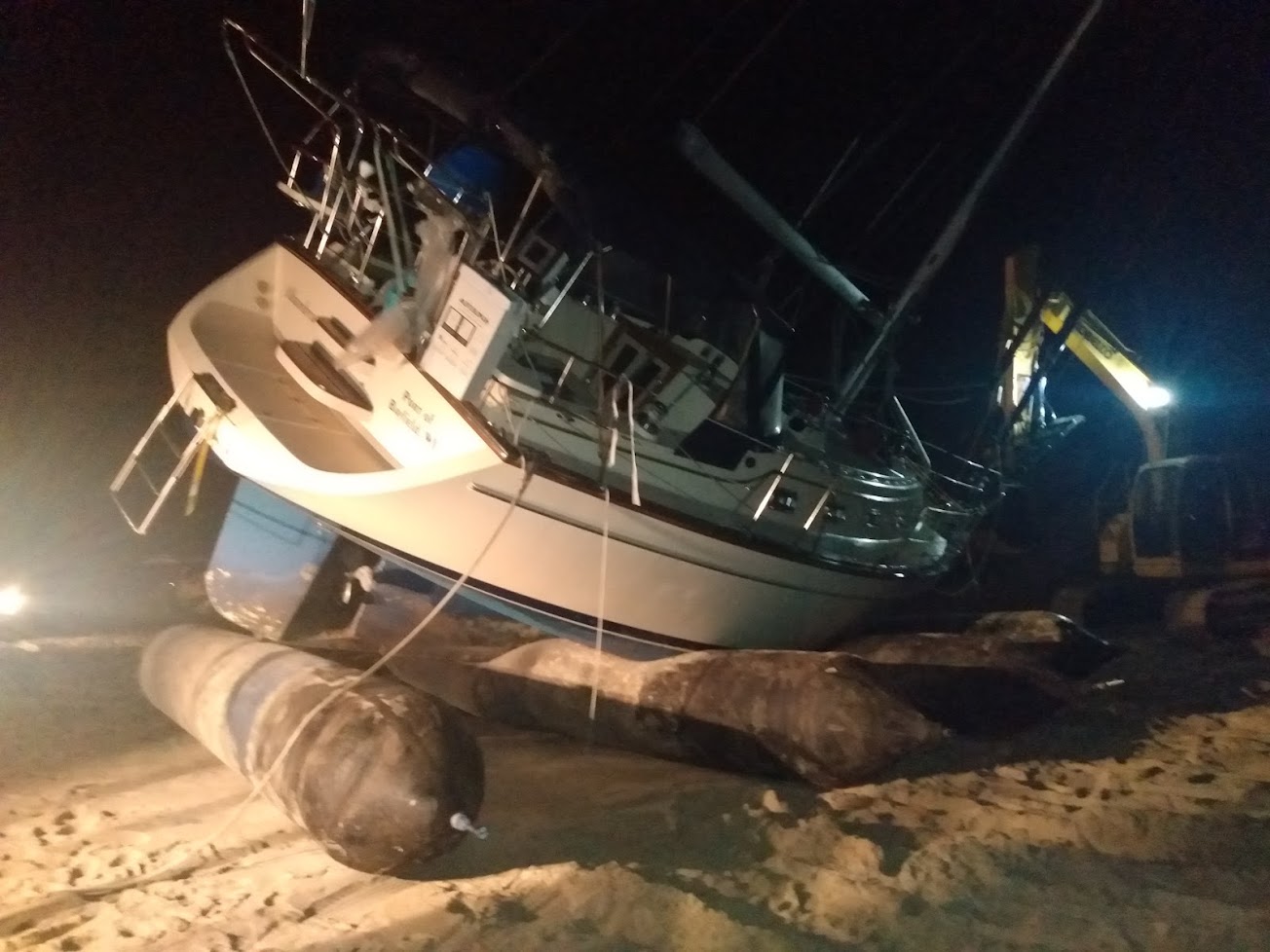
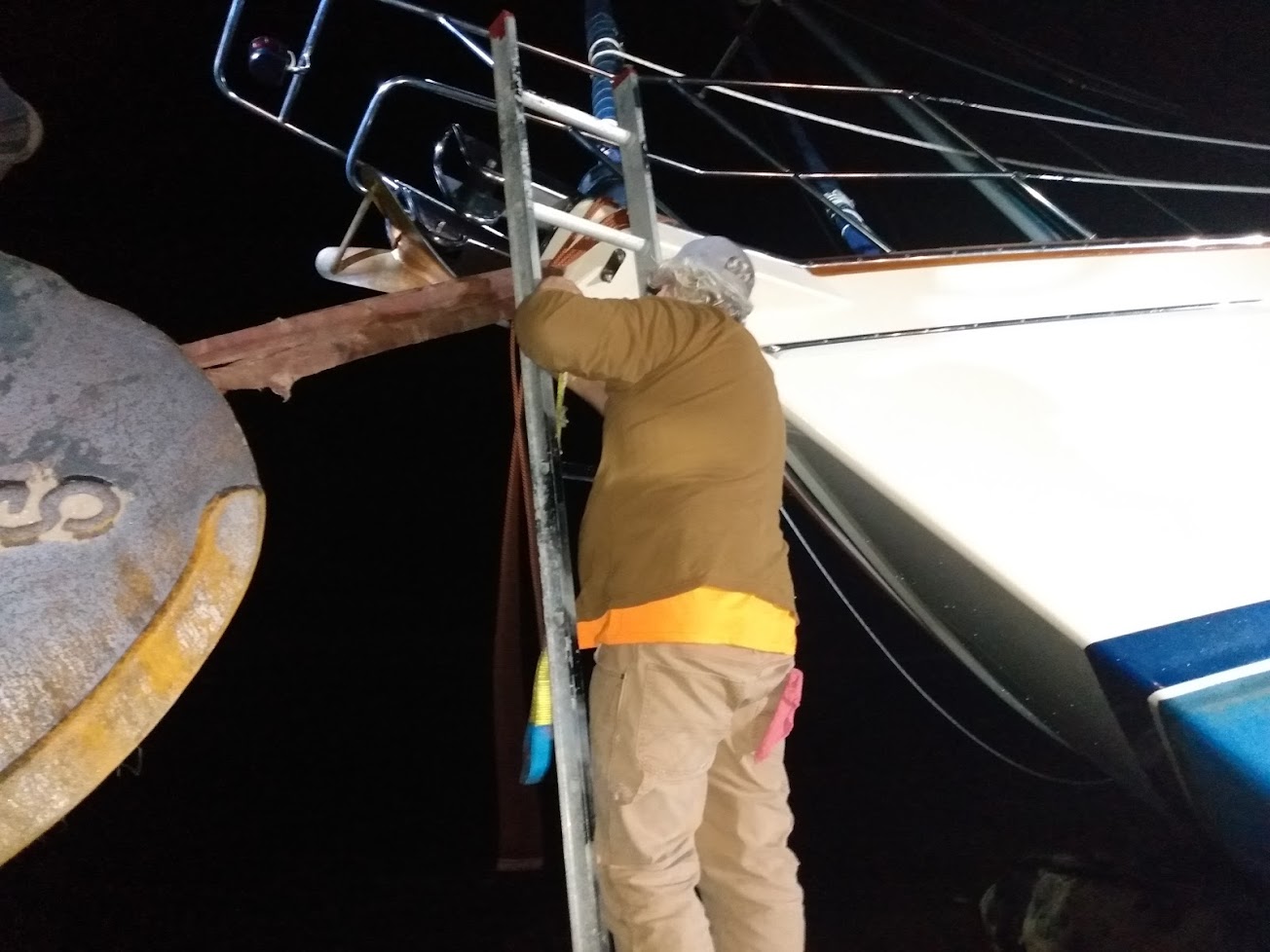
Case in Point – Island Packet Rescue Dec 2021
On December 11, 2021 I walked walked out of our house in Avon to the beach and there was a beautiful Island Packet 37 Full Keel Sailboat grounded and rolling around in the surf very close to Avon Pier. Because of its full keel design, this vessel faired amazingly well through the torment of being washed ashore and over the shallow bar by 10 ft waves. The operator/owner was solo and this was one of the first winter gales of the season. As described above, he underestimated the circumstances that can close in on anyone while approaching Cape Hatteras in the Winter. Heavy and lightly powered full keel boats like this do not move well against adverse winds and currents. Every wave stops the boat’s forward motion. After leaving Cape Henry, with the intentions for Moorehead City and Beaufort, the weather changed and the owner found himself not making any headway. The intensity of the gale increased and waves heights grew to break as far out as a mile from shore on the random shoals. Alone and in darkness, all this became very frustrating and disorienting to the new boat owner. He called the Coast Guard for assistance and tried to hold his position while help was on its way. In this area sandbars run successively parallel to the beach, each one deeper than the previous and there can be as many as 3 – 4 bars outward as far as a half mile. Encountering breaking waves on the outer sand bars, the situation quickly became worse until the boat ended up entirely ashore. Late that night Hatteras Ocean Rescue assisted the owner off the boat near Avon Pier and got him into a hotel room to warm up and get oriented.
By the mid day the next day, Phillips Boatworks crew was able to get on board and check the hull for structural integrity and rig it for high load towing with special dyneema rigging. After transferring their trailers and equipment to the location, Crum Works team started immediately moving the boat to higher ground to avoid the risk of the vessel moving into Avon Pier. This secured the vessel until the insurance company, National Parks Service and USCG could decide whether to move the boat off the beach by trailer or to relaunch it and tow it to Buxton Boatyard on the Sound Side. The decision making and price negotiation process took much more time than the actual salvaging of the vessel, but after 2.5 days a decision was rendered to allow our team to complete the rescue and salvage operation. Most of the Dec 15th was spent waiting for permits from the National Parks administration to finish the job. But by the end of the 4th day (Dec 15), the boat was back in the water and on its way to the boatyard. Meanwhile I got on board and started analyzing the damaged steering system. The vessel would be hard to tow with no steering, so this was critical to the decision whether to decommission the rig and trailer, or slide it back into the Ocean and tow it away. The rudder on this model was very well protected by the full keel. Wave action had pushed the pinion system past its stops and jammed the steering, but this was fairly easy to correct. Bearings and other possible water inlets seemed to be undamaged.
Some vital tools for safe salvage work were necessary. Phillips Boatworks brought its rigging, professional captaining, and boat construction experience to the table. Barry Crum brought his heavy equipment (bobcat, escavator, forklift, industrial air compressor and 30′ tubular airlift bags). His heavy equipment team facilitated moving the boat into position at the rip current cut through the sandbar. Capt. Jay Phillips and his son Noah helped rig the boat for high load towing and braking. The boat wanted to roll freely down the beach slope if not held back. Finding ways to rig attachment point for tow connections that would not cause damage to the vessel is always a challenge. Dock Cleats are not designed to lift or pull the entire weight of a boat on dry land, so alternative loading points must be found and macgiver’d to be safe and secure for the moving process. Forward pull points were rigged via multiple dyneema lashings around the mast and the bow pulpit. Rear pull points were distributed around the 2 primary winches and 4 stern cleats. With these attachment points the heavy equipment team could feel secure that the towing points wouldnt snap off and spring back to injure anyone or damage the vessel.
While the powers that be, decided who was paying for all this work, Phillips Boatworks spent several hours out in the water sounding the deepest route through the sandbars. An attempt was made to jet in some piles, but the rip and side shore currents were 2 – 4 knots, making it impossible to dig an underwater piling into the sand. The current just along the waters edge in this location was intense from the North. We kept the Jet Ski anchored just behind the beach break, and it was not easy getting to it and unhooking from the anchor. We eventually cut the line on the last attempt, leaving the anchor in the sand.
The lift tubes, or bags were used as soft rollers to move the boat about 100 yds down the beach to the deepest water exit that could be found. Once positioned near the waters edge at low tide with the bow facing the Ocean, it was time to reposition the tubes so that they would lift the boat while in the water. The tidal range this day was about 2 – 3 feet. Hopes were for the waves to decrease from 6-8 feet to 2 feet as forecasted. This did not happen and the weather started moving in for the next frontal system and gale as the day progressed. Phillips made special high load webbing bands at our canvas/sail shop to be slipped around the Lift Tubes. This provided 8 connection points on the tubes to be run longitudinally under the keel in a lifting cradle configuration. With strategic rigging, the whole lifting apparatus allows for shallower draft while the vessel was towed through the surf. The bags created a cushion so damage risk in the surf was minimized. Lastly, once clear of the waves, the lift bags could be easily and quickly separated from the boat and towed back and recovered on shore.
Connecting tow lines in the surf and cold water is also an underestimated challenge. Large towing vessels do not want to risk ending up in the surf, so the distance from shore to towing vessel is substantial, and necessitates a sound strategy to avoid people getting hurt. The large diameter tow line is heavy and can not be simple pulled out to sea by a person. Sideshore currents in big surf exceeded 4 knots at times and created a strong sag in the line down the beach. This was not something a person could walk or swim out. It was difficult to deal with, so some sort of intermediate vessel is needed that can get through the surf. Phillips Boatworks used a 3 person jet ski to first run a 500 ft light feeder line past the surf break to the towing vessel. All the towing feeder lines and hawser line had to be laid out on the beach, then the 2″ Polypropylene hawser tow line was attached and towed out against the current with hydraulic winches aboard the towing vessel. None of this would have been able to happen successfully without proper equipment and teamwork. The towing vessel operated by Tilgman Gray was a 45′ Deadrise with about 600hp of low torque diesel power, hydraulic winches, etc. with 2 crew aboard. The challenge of towing a 30,000 keelboat in through Hatteras Inlet, navigating the shallow ferry channels soundside of the inlet sandbars and shoals was something only a waterman with countless days of sea-time and local knowledge could do.
The Island Packet 37 recovery was a resounding success. Not only was there minimal damage to the vessel, but the beach, Avon Pier, the boat owner and insurance company all benefited by competent salvage and recovery efforts from Barry and his crew at Crum Works Inc., along with the vessel and rigging experience at Phillips Boatworks. Then the seamanship and well equipped towboat work by Tilgman Gray all combined to be a successful partnership and team effort.
